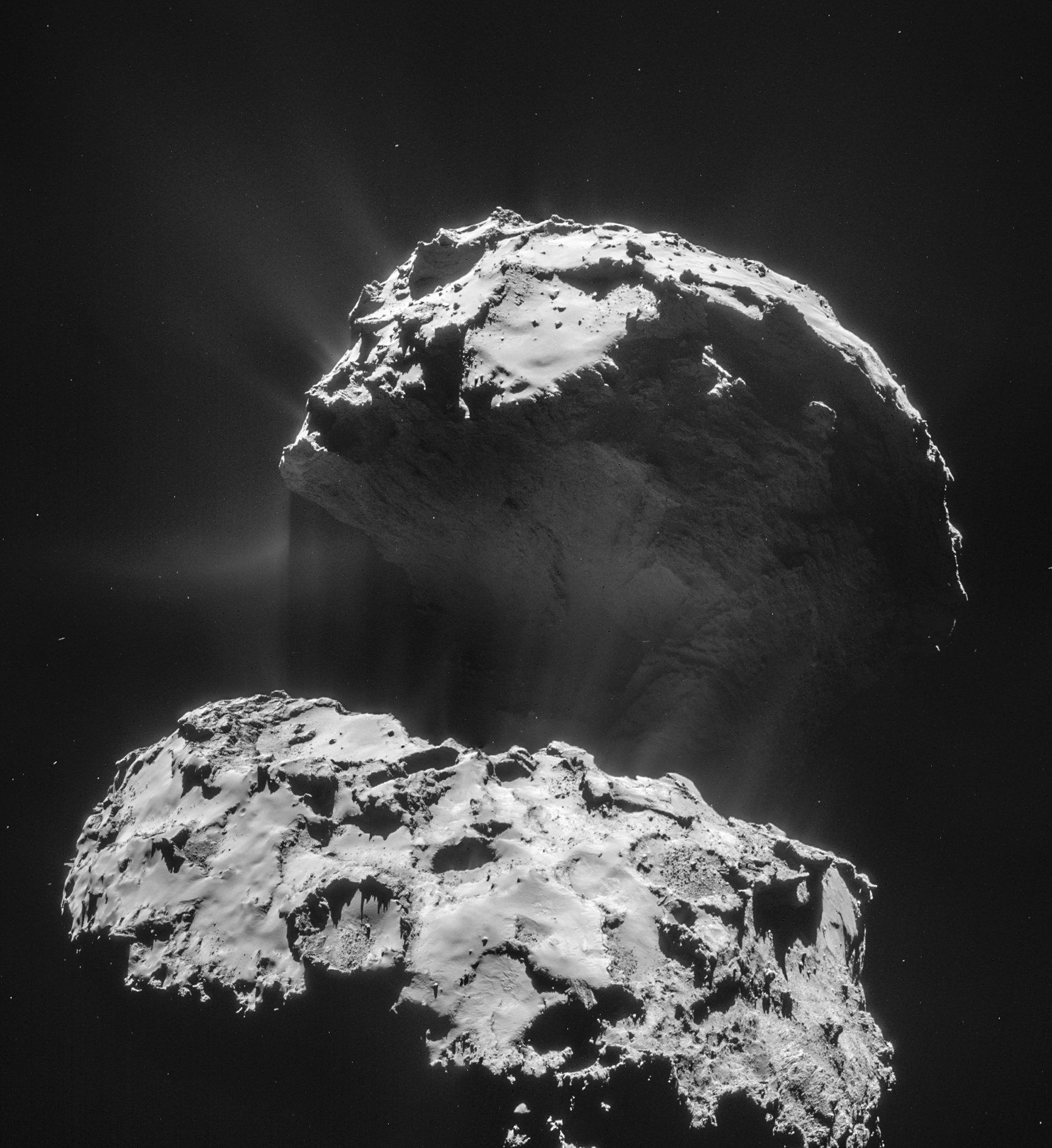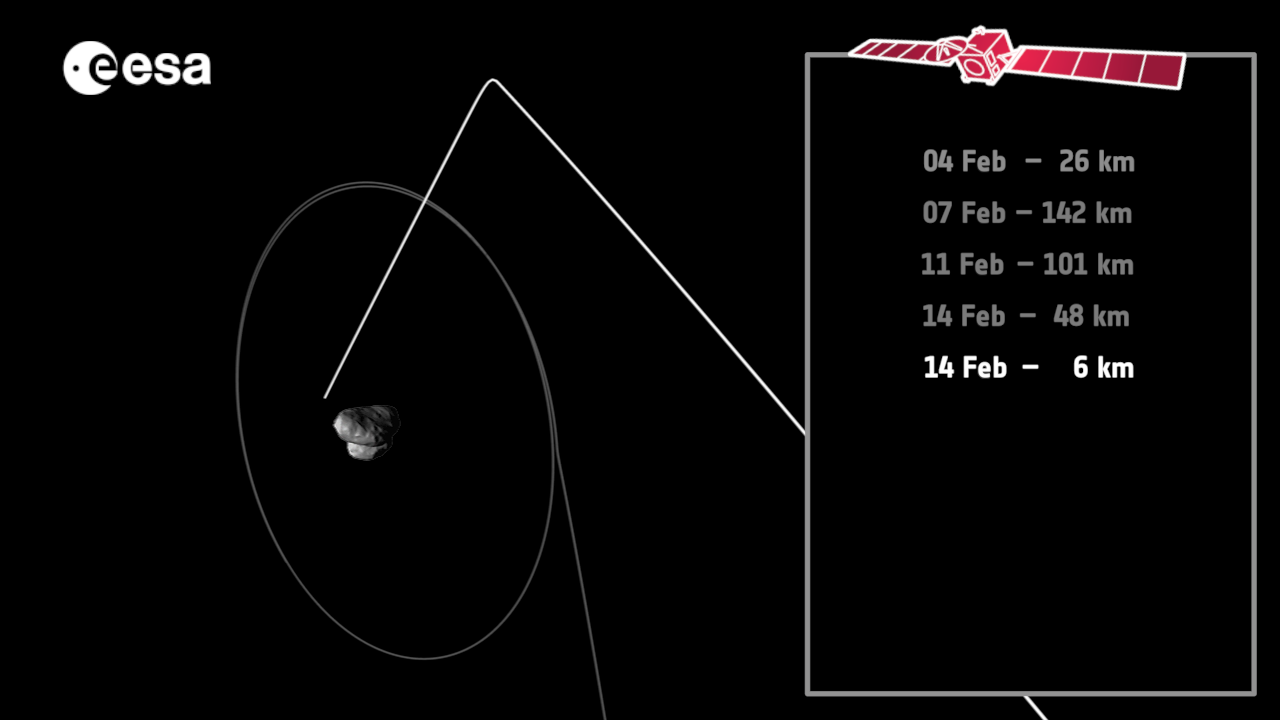
This four-image mosaic comprises images taken from a distance of 28.7 km from the centre of Comet 67P/Churyumov-Gerasimenko on 3 February and released on 9 February 2015. The image resolution is 2.4 m/pixel and the individual 1024 x 1024 frames measure 2.5 km across. The mosaic measures 4.2 x 4.6 km. Credits: ESA/Rosetta/NAVCAM – CC BY-SA IGO 3.0
Europe’s Rosetta spacecraft has captured the most spectacular imagery yet of comet 67P/Churyumov-Gerasimenko spewing forth gas and dust during what the team dubbed “The Last Waltz” as the frigid celestial body inexorably heats up, and the probe was successfully retargeted for a super-close encounter on Valentine’s Day.
The new images were taken by the probe’s navcam camera on Feb. 3 from a distance of 29 kilometers (18 miles) and were released by the European Space Agency (ESA) on Feb. 9.
Engineers fired up the Rosetta orbiter’s onboard thrusters on Feb. 4, placing it on course to swoop down to within 6 kilometers (3.8 miles) of the bizarre comet’s pockmarked surface for its closest flyby yet, on Saturday, Feb. 14, coincidentally coinciding with Valentine’s Day.
Saturday’s close encounter starts a new phase of the mission. After departing its bound orbit around the comet at a distance of 28 km from the center, Rosetta will conduct a series of flybys over varying distances during the coming year.
On Valentine’s Day, the ESA probe will “sniff” and “taste” the comet’s growing coma, or atmosphere, of gas and dust blasting off from the nucleus of 67P. The odd-shaped body is heating up as it moves ever closer to the warming Sun, causing sublimation of subsurface ices and outbursts of spewing gases and dust.
“The upcoming close flyby will allow unique scientific observations, providing us with high-resolution measurements of the surface over a range of wavelengths and giving us the opportunity to sample – taste or sniff – the very innermost parts of the comet’s atmosphere,” says Matt Taylor, ESA’s Rosetta project scientist, in an update.

The probe first traveled outbound to a distance of roughly 140 km from the comet by Feb. 7 before swooping back in. As of today, Feb. 11, Rosetta is 104 km away and closing in moment by moment for the cosmic kiss.
The Valentine’s Day flyby actually marks the closest that ESA’s robotic probe will approach the rubber ducky-shaped comet during its prime mission. The closest pass is timed to take place at 12:41 GMT (7:41 EST, 13:41 CET) over the larger of the comet’s two lobes, above the Imhotep region.
“It is the earliest we could carry it out without impacting the vitally important bound orbits that are currently being flown,” noted Taylor recently.
ESA reports today that the navcam camera has been programmed to take images shortly before and after close approach on Saturday, and they will be downlinked to Earth on Sunday and Monday. So stay tuned here!
“My new trajectories let me study 67P’s surface & taste & sniff its coma from range of distances. Lots of science to do!” the orbiter tweeted today.
Rosetta is escorting comet 67P around the Sun and both are approaching ever closer to the Sun along the orbital track.
As of today, the pair are 499 million km from Earth and 352 million km from Sun. They will reach perihelion on Aug. 13, 2015, at a distance of 186 million km from the Sun, between the orbits of Earth and Mars.

As the pair fly nearer, the comet’s nucleus will become even more active, belching out even more gas and dust which is a boon for comet science, but also rather risky for the spacecraft’s health.
“As the comet becomes more and more active, it will not be possible to get so close to the comet. So this opportunity is very unique,” Taylor elaborated.
During the ultra-low flyby, Rosetta’s cameras will image the comet with an unprecedented resolution of a few inches (tens of centimeters) per pixel.
The imagery is expected to yield even better data on the comet’s porosity albedo and a host of other properties from the 11 state-of-the-art science instruments.
Rosetta is targeted to flyby over the most active regions of the comet so that scientists can correlate the jets of activity with the composition of the coma and how it evolves and changes at increasing distance from the surface.
Researchers hope to pinpoint the sources of the outflowing gas and dust.
Lengthy cracks in the neck region, named Hapi, and running over 500 meters long, have already been detected in prior images, as reported here.
“Rosetta is providing us with a grandstand seat of the comet throughout the next year. This flyby will put us track side — it’s going to be that close,” said Taylor.
The flyby will also allow the study of the processes by which cometary dust is accelerated by the cometary gas emission, according to the team.
Here’s an ESA video showing the flyby trajectory:
Video caption: Animation showing the manoeuvres surrounding Rosetta’s close flyby of Comet 67P/Churyumov-Gerasimenko on 14 February 2015. Credit: ESA
Throughout 2015, Rosetta will observe the comet from varying distances that will also provide context for the data returned.
“We’re in the main science phase of the mission now, so throughout the year we’ll be continuing with high-resolution mapping of the comet,” says Taylor.
“We’ll sample the gas, dust and plasma from a range of distances as the comet’s activity increases and then subsides again later in the year.”
Over the next month alone, Rosetta will study the comet from a distances between 6 km and 253 km.
The comet is comprised mostly of water ice and dust, is fluffy, and has a very high porosity of 70 to 80 percent. So it would float on water.
“The nucleus surface itself appears rich in organic materials, with little sign of water ice,” says Taylor.
The diminutive dual-lobed body measures only about 4 kilometers (2.5 mile) wide.
And it’s getting smaller all the time, due to the outbursts caused by Sun-driven erosion—more on that next time.

Stay tuned here for continuing developments.
Want to keep up-to-date with all things space? Be sure to “Like” AmericaSpace on Facebook and follow us on Twitter: @AmericaSpace




